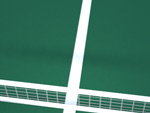Tennis

Backhand
The backhand is a tennis shot in which one swings the racquet around one's body with the back of the hand preceding the palm. Except in the phrase backhand volley, the term refers to a groundstroke (that is, one in which the ball has bounced before it is struck). It contrasts with the other kind of groundstroke, the forehand. The term is also used in other racquet sports, and other areas where a similar motion is employed (for example while throwing a sport disc).
The backhand is usually performed from the baseline or as an approach shot. For a right-handed player, a backhand begins with the racquet on the left side of the body, continues across the body as contact is made with the ball, and ends on the right side of the body, with the racquet over the right shoulder. The backhand can be a one-handed or two-handed stroke.
Due to the fact that the player's dominant hand "pulls" into the shot, the backhand generally lacks the power and consistency of the forehand, and is usually considered more difficult to master. However, the two-handed backhand provides more stability and power for the shot, and is increasingly used in the modern game. Beginner and club-level players often have difficulty hitting a backhand, and junior players may have trouble making the shot if they are not strong enough to hit it. Many advanced players still have a significantly better forehand than backhand, and many strategies in tennis aim to exploit this weakness.
Grips
For most of the 20th century, the backhand was hit with one hand using either an eastern or continental grip. The first notable players to use a two-handed backhand were the 1930s Australians Vivian McGrath and John Bromwich. Beginning with Mike Belkin who was the first two-handed backhand player in the United States and Chris Evert in the 1960s, many players began to use a two-handed grip for the backhand. Pete Sampras and Stefan Edberg notably switched from the two-handed to the one-handed backhand late in their development.
Strengths and weaknesses
- Often players choose their backhand type based on their hand dominance—if the player is somewhat ambidextrous, the two-handed backhand might be best.
- Starting from the 1970s, many of the greatest players used the two-handed backhand and it has become more popular on the pro tour. Two-handed backhands have some important advantages over one-handed backhands:
- The backhands are generally more accurate because having two hands on the racquet makes the contact more stable. This also makes it somewhat easier to impart topspin on the ball (though not as much) allowing for more control of the shot, while one-handed backhands generally require finer motor skills to generate topspin and are less consistent in longer rallies.
- Two-handed backhands can more easily hit higher balls.
- Two-handed backhands have a chance to be consistently closer in power and/or accuracy to the forehand, possibly even surpassing it, which is not the case with the one-handed. People with a noticeably weaker one-handed backhand tend to get balls returned to them on that wing, giving them a disadvantage, especially with high kick serves and lefty slice serves.
- Two-handed backhands can be hit with an open stance, whereas one-handers usually have to have a closed stance, which adds further steps (which is a problem at higher levels of play).
- Two-handed backhands can change direction more easily than one-handed backhands, due to having more stability over the shot with two hands, allowing the player to control the shot better and place the ball with more precision.
- Two-handed backhands are generally more easy to develop and require less motor skills than a one-handed backhand to perform all the basic shots. Since the 70s, juniors have been taught two-handed backhands more often than the one-handed backhand.
- However, one-handed backhands have some other important advantages over two-handed backhands:
- One-handed backhands allow greater reach, especially while on the run.
- One-handed backhands are able to hit lower balls with more pace and penetration than two-handed backhands. They also can generate more power when properly set up, and can be very penetrating when hit correctly.
- One-handed backhand players move to the net with greater ease than two-handed players because the shot permits greater forward momentum and has greater similarities in muscle memory to the preferred type of backhand volley (one-handed, for greater reach). This is why a majority of serve and volleyers employ a one-handed backhand.
- One-handed backhands should be hit more in front of the body than the forehand, which allows them to be hit with a deeper hit spot.
- One-handed-backhand players are much less likely to develop the habit of playing volleys with two hands, which is better for serve and volley play.
- One-handed backhands force players to hit high balls with slice, thus causing them to develop much better slice backhands than two-handed players.
- One-handed backhands can be put away more easily than two-handed backhands for finishing shots due to their flatter, more penetrating nature.
Generally, both backhands are efficient at what they do. The type of backhand a player uses comes down to mostly personal preference and their game style. Since the 1970s however, the two-handed backhand has had a spike in popularity and is now more widely taught than the one-handed backhand.
Technique
Despite there being many different variations and styles, in general there are three different techniques to hit the one-handed backhand. The first is the slice, the oldest version of the single-handed backhand, which was popularised by many classic players such as Ken Rosewall and was still used up until the 1980s even in the women's tour, with many great women champions such as Steffi Graf having one of the lowest, most effective slice backhands. The slice backhand is considered the most simple and is the easiest to learn technique-wise. However, it is much harder to master. Unlike the slice on its own, the slice backhand refers to a player continuously using slice on their backhand as an ordinary shot, instead of for variety. Most slice backhands are executed with a continental grip, identical to that of the backhand volley. The motion is also simple, and involves a cut at about 45 degrees to the bottom of the ball. The slice action closer to the bottom results in a higher and slower ball, typically used for lobs while a cut closer to the side of the ball results in a faster and lower ball. It is considered hard to be able to consistently pull off deep, low yet quick backhand slices and requires lots of practice and finesse. Such slice backhands often prevent opponents from getting under the ball easily and hitting easy winners. It also slows down the pace of the ball due to the back-spin on it, giving time for the player to anticipate and set up shots. For example, Steffi Graf often used her slice backhand to buy time for her to move around and hit inside-out forehands, her signature shot. It can also act as a good bluff to hit drop-shots or even fake drop-shots.
From the 1940s to the 1960s, the flat single-handed backhand was popularised by many players, most famously Rod Laver and Don Budge. He was one of the first players to use a flat single-handed backhand with a hint of top-spin. While it should be noted that flat or top-spin shots were not rare at the time, they were not common shots and were used mainly for variety only, especially on the backhand side. These shots were generally faster-paced, but were considered harder to learn and execute. Even today, there are still many players who use the flat single-handed backhand, such as Stan Wawrinka and Roger Federer, although they have added more top-spin to cope with top-spin from other players as well. However, by the 1980s, the flat single-handed backhand was the norm for most single-handed backhand players, with players such as John McEnroe and Pete Sampras using it to great effectiveness. The advantages of the flat single-handed backhand include its speed, the angles it can produce and its depth. It is usually executed with an Eastern or Semi-Western grip, and involves a "throw-back" in which the racket is pulled across the player's body, sometimes with the help of the left hand, and a release to hit the ball followed by a much larger follow-through and finish as compared to the slice backhand.
While Björn Borg was considered to have had a double-handed backhand, he released his racket with one-hand, and was arguably the catalyst for the evolution and popularity of the double-handed backhand as well as the top-spin single-handed backhand. In the 1980s, when more players were using top-spin, single-handed backhand players found it more difficult to hit flat backhands due to the difficulty of neutralising the spin. Therefore, many players incorporated much more top-spin in their single-handed backhands, which was uncommon at that time. Up til today, many players who are considered to have some of the best single-handed backhands ever, such as Richard Gasquet, use a top-spin backhand. Other current players who use it include Nicolás Almagro and Grigor Dimitrov (Although he is also capable of hitting it flat). This helped single-handed backhand players cope with high spinning balls. The advantages of the top-spin single-handed backhand include consistency, placement, the angles it can produce as well as its ability to cope with high balls. Single-backhand "flicks" also evolved due to the popularisation of the top-spin single-handed backhand. Unlike the flat single-handed backhand, top-spin single-handed backhands are almost always performed with the Semi-Western or even Western Grip. Richard Gasquet, who is considered to have one of the most elegant and efficient single-handed backhands, is known for his long, winding action on his backhand and his elegant follow-through. The top-spin single-handed backhand is probably the hardest to learn. It involves the player employing a Semi-Western or Western grip, and winding the racket around his body and, most importantly, bring it lower than the ball. Then, he has to hit the ball at the middle to bottom of the ball while winding his hand upwards and front of him, in a "window-wiper" action. A mistake that is often made in this execution is not bringing the racket low enough or not having a follow-through.
Many great players employ a combination of two or even three different styles. For example, Stan Wawrinka, who is said to have one of the most powerful single-handed backhands ever, can hit extremely flat backhands, but can also apply top-spin to them. Roger Federer and Grigor Dimitrov are able to apply all three, using the slice, flat and top-spin backhands effectively. This variety makes it hard for the opponent to guess what kind of shot they are going to play.
SPORTS

RESOURCES
This article uses material from the Wikipedia articles "Tennis" and "Backhand", which is released under the Creative Commons Attribution-Share-Alike License 3.0.
© Stories Preschool. All Rights Reserved.









